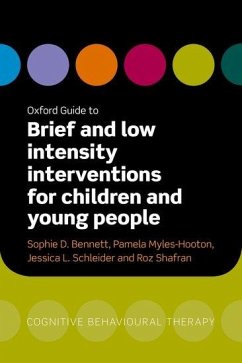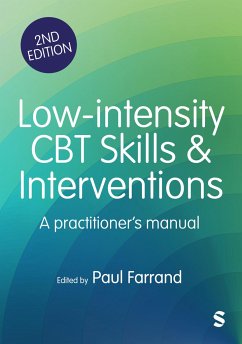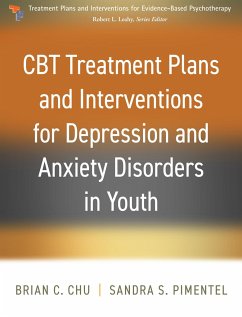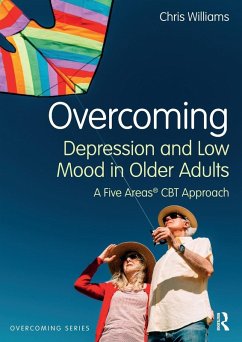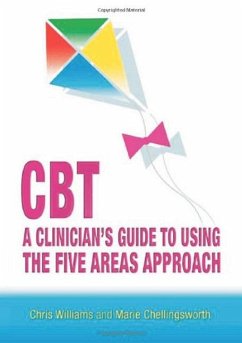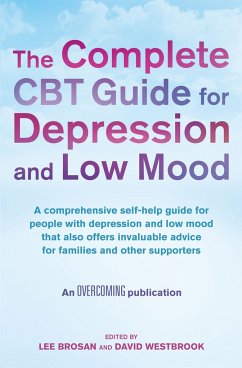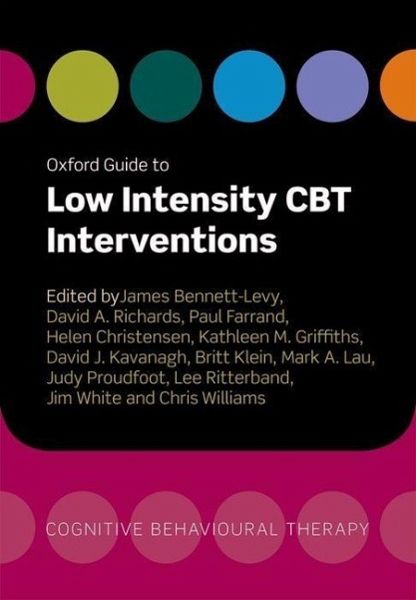
Broschiertes Buch
Oxford Guide to Low Intensity CBT Interventions
Versandkostenfrei!
Versandfertig in 2-4 Wochen

PAYBACK Punkte
42 °P sammeln!




The Oxford Guide to Low Intensity CBT Interventions is the first ever comprehensive guide to Low Intensity CBT. It brings together researchers and clinicians who have led the way in developing evidence-based low intensity CBT treatments - treatments for those who have hitherto had no access to mental health services.
James Bennett-Levy is Associate Professor in Mental Health at Sydney University's Department of Rural Health (Northern Rivers) in northern New South Wales, Australia. As soon as he was appointed to the position, he saw the potential of low intensity CBT interventions for rural and remote communities, where access to evidence-based psychological therapies tends to be very poor. Recognising the absence of a useful low intensity CBT textbook to guide practitioners and decision makers, he initiated and co-ordinated the Oxford Guide to Low Intensity CBT Interventions. In his research work, he is one of the world's leading leading researchers on CBT training with a series of empirical and theoretical papers. David Kavanagh holds a Research Chair in the Institute of Health & Biomedical Innovation and School of Psychology & Counselling at Queensland University of Technology in Brisbane. Much of his research has been on brief or low-intensity interventions, and improvement of mental health service delivery via training and supervision. His research has included evaluations of remotely delivered treatment by mail, and more recently using the internet and text messaging. Professor Kavanagh has an extensive record of research funding and publications, and his work is widely cited. He is currently on the Academy of the National Health and Medical Research Council, and the Science, Academia and Research Advisory Group of the Australian Psychological Society. He is co-chair of the Queensland Health Collaborative on Alcohol and Other Drugs and Mental Health, and serves on state and Commonwealth consultative committees on services for mental disorders and substance misuse. Mark Lau is a Research Scientist and Director, BC Cognitive Behaviour Therapy Network with BC Mental Health and Addiction Services, an agency of the Provincial Health Services Authority where he is co-ordinating a series of projects to disseminate CBT across the province of BC. He is also a Clinical Associate Professor of Psychiatry at UBC and a Founding Fellow of the Academy of Cognitive Therapy. Dr. Lau's research interests include evaluating effective methods of CBT dissemination, investigating the mechanisms underlying the efficacy of Mindfulness-based Cognitive Therapy (MBCT), and the further development and validation of the Toronto Mindfulness Scale. In addition, Dr. Lau has led workshops in Cognitive Behaviour Therapy and MBCT across Canada, in the United States, United Kingdom and Australia. David A Richards is Professor of Mental Health Services Research at Exeter University's Mood Disorders Centre in the UK. Throughout his career, he has tirelessly campaigned to improve access to evidence-based therapies such as CBT. He has been involved in the UK's Improving Access to Psychological Therapies (IAPT) programme from its inception in 2005 and developed the low-intensity CBT methods used by IAPT on behalf of the UK Department of Health. As such he can be credited with personally establishing a completely new profession of low-intensity CBT workers in the UK, now known as Psychological Wellbeing Practitioners. In his spare time he runs a multi-centre research team funded by the Medical Research Council and the National Institute for Health Research which develops and tests new models of delivering treatment in clinical trials - including stepped care, guided self-help and collaborative care. Lee Ritterband is an Associate Professor at the University of Virginia Health System Department of Psychiatry and Neurobehavioral Sciences and Director of the Behavioral Health and Technology program area. With degrees in clinical psychology and computer science/technology, Dr. Ritterband specializes in the development and testing of behaviorally-based treatment programs delivered via the Web. Over the past decade, Dr. Ritterband has established himself as one of the leading researchers in Internet health interventions. He has been a Principal or Co-Investigator on many large research projects funded by the National Institutes of Health. In 2003, Dr. Ritterband was honored with the award, Best eHealth Research Paper of the Year, sponsored by the Health e-Technologies Initiative, National Program Office of the Robert Wood Johnson Foundation for eHealth. Chris Williams is Professor of Psychosocial Psychiatry at the University of Glasgow, UK. He became interested in low intensity working in the mid-1990's when he completed a postgraduate CBT course, but found he struggled to offer one hour CBT appointments in his everyday work. He sees low intensity working as bringing together two themes he is particularly interested in - CBT and education/teaching - and views CBT as a self-help form of psychotherapy. He researches CBT self-help in psychiatric and community settings and has developed a range of book-based, DVD, class-based and computer-delivered self-help resources including the free access www.livinglifetothefull.com website which receives around 2 million hits a month. His work developing the five areas model of CBT is focused on making CBT accessible to practitioners and the general public alike. Together his CBT self-help books are amongst the most used in the UK. He is Patron of the charities Anxiety UK and Triumph over Phobia. Jim White is a consultant clinical psychologist and currently leads the STEPS primary care mental health team in south-east Glasgow. He has mainly worked in primary care settings and has a reputation for innovation in his approach to common mental health problems. In particular, he is interested in getting to much larger numbers of people a lot sooner, empowering them to make real choices about how they want to tackle their problems and to work with them in ensuring they are able to act on their choices. The STEPS approach is possibly one of the most radical approaches in primary care mental health in Britain. We are a Scottish Executive Exemplar Project. STEPS offers a 6 level stepped-care approach: § Individual therapy § Group work § Single contacts § Non-face-to-face interventions § Working with others § Awareness raising / community involvement / early intervention and prevention Britt Klein is the Co-Director of the National eTherapy Centre; the Co-Director of the Swin-PsyCHE e-Therapy Unit; and an Associate Professor in the Faculty of Life and Social Sciences at Swinburne University, Melbourne, Australia. Since 1998 she has been developing and evaluating internet-based mental and physical health interventions as a means to increase access to health services by utilising low intensity CBT intervention modalities. Her biggest achievement to date is the co-creation of Anxiety Online (www.anxietyonline.org.au): a full service education and training, online psychological assessment and treatment clinic for the anxiety disorders open to the general public. She has been awarded numerous grants to develop and evaluate internet-based wellbeing, prevention and treatment programs, has published widely, teaches and supervises students in the field of internet interventions and she is the Co-Editor of the e-Journal of Applied Psychology.
Produktdetails
- Oxford Guides to Cognitive Behavioural Therapy
- Verlag: Oxford University Press
- Seitenzahl: 632
- Erscheinungstermin: 13. Mai 2010
- Englisch
- Abmessung: 246mm x 174mm x 41mm
- Gewicht: 1092g
- ISBN-13: 9780199590117
- ISBN-10: 0199590117
- Artikelnr.: 32309600
Herstellerkennzeichnung
Libri GmbH
Europaallee 1
36244 Bad Hersfeld
gpsr@libri.de
Für dieses Produkt wurde noch keine Bewertung abgegeben. Wir würden uns sehr freuen, wenn du die erste Bewertung schreibst!
Eine Bewertung schreiben
Eine Bewertung schreiben
Andere Kunden interessierten sich für


